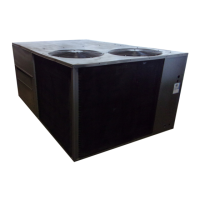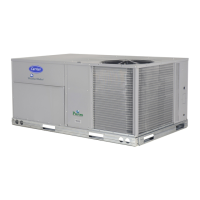35
Table 27 — Alarm Codes
LEGEND
ALARM OR
ALERT
NUMBER
DESCRIPTION
ACTION TAKEN
BY CONTROL
RESET
METHOD
PROBABLE CAUSE
T051
Compressor A1 Safety Trip Add Strike for Circuit A Automatic High-pressure switch open. Check for T126 Compressor internal pro-
tection open. Wiring error
Compressor A1 Current Detected After Turnoff Turn off all compressors Automatic Welded contactor
T055
Compressor B1 Safety Trip Add Strike for Circuit B Automatic High-pressure switch open. Check for T127 Compressor internal pro-
tection open. Wiring error
Compressor B1 Current Detected After Turnoff Turn off all compressors Automatic Welded contactor
T059
Compressor C1 Safety Trip Add Strike for Circuit C Automatic High-pressure switch open. Check for T142 Compressor internal pro-
tection open. Wiring error
Compressor C1 Current Detected After Turnoff Turn off all compressors Automatic Welded contactor
T064
Circuit A Saturated Condensing Temp Thermistor
Failure
Use OAT to control Outdoor fans Automatic Faulty, shorted, or open thermistor caused by wiring error or loose
connection.
T065
Circuit B Saturated Condensing Temp Thermistor
Failure
Use OAT to control Outdoor fans Automatic Faulty, shorted, or open thermistor caused by wiring error or loose
connection.
T073
Outdoor Air Temperature Thermistor Failure — Automatic Faulty, shorted, or open thermistor caused by wiring error or loose
connection.
T074
Space Temperature Thermistor Failure Unit shutdown Automatic Faulty, shorted, or open thermistor caused by wiring error or loose
connection.
T075
Supply Air Temperature Thermistor Failure — Automatic Faulty, shorted, or open thermistor caused by wiring error or loose
connection.
T080
Circuit C Saturated Condensing Temp Thermistor
Failure
Use OAT to control Outdoor fans Automatic Faulty, shorted, or open thermistor caused by wiring error or loose
connection.
T092
Circuit A Suction Pressure Transducer Failure Shutdown Circuit A Manual Faulty transducer, faulty 5-V power supply, or loose connection
T093
Circuit B Suction Pressure Transducer Failure Shutdown Circuit B Manual Faulty transducer, faulty 5-V power supply, or loose connection
T101
Circuit C Suction Pressure Transducer Failure Shutdown Circuit C Manual Faulty transducer, faulty 5-V power supply, or loose connection
T102
Compressor A1 Current Sensor Failure — Automatic Faulty current sensor caused by wiring error or loose connection
T103
Compressor B1 Current Sensor Failure — Automatic Faulty current sensor caused by wiring error or loose connection
T104
Compressor C1 Current Sensor Failure — Automatic Faulty current sensor caused by wiring error or loose connection
T110
Circuit A Loss of Charge Shutdown Circuit A Manual Low refrigerant or faulty suction pressure transducer
T111
Circuit B Loss of Charge Shutdown Circuit B Manual Low refrigerant or faulty suction pressure transducer
T126
Circuit A High Refrigerant Pressure Shutdown Circuit A Automatic An overcharged system, high outdoor ambient temperature coupled
with dirty outdoor coil, plugged filter drier, or a faulty high-pressure
switch.
T127
Circuit B High Refrigerant Pressure Shutdown Circuit B Automatic An overcharged system, high outdoor ambient temperature coupled
with dirty outdoor coil, plugged filter drier, or a faulty high-pressure
switch.
T133
Circuit A Low Refrigerant Pressure Add Strike for Circuit A Automatic Low refrigerant charge, dirty filters, evaporator fan turning backwards,
loose or broken fan belt, plugged filter drier, faulty transducer, exces-
sively cold return air, or stuck open economizer when the ambient
temperature is low.
T134
Circuit B Low Refrigerant Pressure Add Strike for Circuit B Automatic Low refrigerant charge, dirty filters, evaporator fan turning backwards,
loose or broken fan belt, plugged filter drier, faulty transducer, exces-
sively cold return air, or stuck open economizer when the ambient
temperature is low.
T140
Circuit C Loss of Charge Shutdown Circuit C Manual Low refrigerant or faulty suction pressure transducer
T141
Circuit C Low Refrigerant Pressure Add Strike for Circuit C Automatic Low refrigerant charge, dirty filters, evaporator fan turning backwards,
loose or broken fan belt, plugged filter drier, faulty transducer, exces-
sively cold return air, or stuck open economizer when the ambient
temperature is low.
T142
Circuit C High Refrigerant Pressure Shutdown Circuit C Automatic An overcharged system, high outdoor ambient temperature coupled
with dirty outdoor coil, plugged filter drier, or a faulty high-pressure
switch.
T143
Circuit A Failure To Pressurize Add Strike for Circuit A Automatic Wiring causing reverse rotation or faulty compressor
T144
Circuit B Failure To Pressurize Add Strike for Circuit B Automatic Wiring causing reverse rotation or faulty compressor
T145
Circuit C Failure To Pressurize Add Strike for Circuit C Automatic Wiring causing reverse rotation or faulty compressor
A163
Circuit A Down Due to Failure Shutdown Circuit A Manual Circuit has 3 strikes or has been locked out by another alarm
A164
Circuit B Down Due to Failure Shutdown Circuit B Manual Circuit has 3 strikes or has been locked out by another alarm
A165
Circuit C Down Due to Failure Shutdown Circuit C Manual Circuit has 3 strikes or has been locked out by another alarm
T179
Loss of communication with the Economizer
Control Board
— Automatic Communication wiring problem with ECB or faulty MBB or ECB
T180
Loss of communication with the Economizer
Actuator
— Automatic Communication wiring problem with actuator.
A404
Fire Shutdown Unit Shutdown Automatic Smoke detected by smoke detector
T408
Dirty Filter — Automatic Dirty Filter
T409
Fan Status Switch ON, Contactor OFF If IDF.F = Yes, then Unit Shutdown If IDF.F = YES,
then Automatic,
otherwise
manual
Bad Fan Status Switch.
Configuration incorrect.
Fan Status Switch OFF, Contactor ON If IDF.F = Yes, then Unit Shutdown If IDF.F = YES,
then Automatic,
otherwise
manual
Tripped Circuit Breaker.
Broken belt.
Bad indoor fan motor.
Configuration incorrect. Bad fan status switch.
Fan Feedback ON when not Expected — Automatic Bad relay.
Fan Feedback OFF when not Expected Compressors will not operate Automatic Bad IGC, wiring problem, or bad MBB relays.
T410
R-W1 Jumper Not Installed in Space Temp Mode Unable to run heat Automatic Missing jumper wire
R-W1 Jumper Must Be Installed to Run Heat In
Service Test
Unable to Test Heat Outputs Automatic Missing jumper wire.
T411
Thermostat Y2 Input Activated without Y1
Activated
Run unit as if Y2 and Y1 are On Automatic Bad Thermostat or Thermostat Wiring
T412
Thermostat W2 Input Activated without W1
Activated
Run unit as if W2 and W1 are On Automatic Bad Thermostat or Thermostat Wiring
T413
Thermostat Y and W Inputs Activated
Simultaneously
Run unit in mode activated first Automatic Bad Thermostat or Thermostat Wiring
T414
Economizer Damper Actuator Out of Calibration Alert Generated Automatic Calibrate economizer (E.CAL). If problem still exist then determine
what is limiting economizer rotation.
Economizer Damper Actuator Torque Above Load
Limit
Alert Generated Automatic Actuator load too high. Check damper load.
Economizer Damper Actuator Hunting Excessively Alert Generated Automatic Damper position changing too quickly.
Economizer Damper Stuck or Jammed Alert Generated Automatic No economizer motion. Check actuator.
Economizer Damper Actuator Mechanical Failure Alert Generated Automatic Check actuator and replace if necessary.
Economizer Damper Actuator Direction Switch
Wrong
Alert Generated Automatic Switch wired incorrect direction.
ECB —
Economizer Control Board
IGC —
Integrated Gas Controller
MBB —
Main Base Board
OAT —
Outdoor-Air Thermistor
→
202

